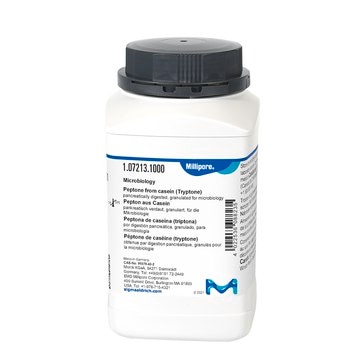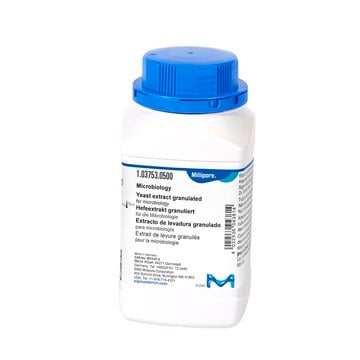T7293
Tryptone
Microbiologically tested.
Synonym(s):
Peptone from casein, Peptone from casein, Pancreatic digest of casein.
About This Item
Recommended Products
biological source
bovine milk
Quality Level
form
powder
quality
Microbiologically tested.
packaging
bottle of 1 kg
bottle of 250 g
nitrogen analysis
11.0-16.0% total
loss
≤6% loss on drying
color
light yellow
pH
6.9-7.4
application(s)
food and beverages
microbiology
suitability
Escherichia coli
Haemophilus spp.
Lactobacillus spp.
Streptococcus spp.
coliforms
Looking for similar products? Visit Product Comparison Guide
Related Categories
General description
application
- Growth media: Tryptone is frequently used as a source of nutrients in growth media for bacteria, yeast, and other microorganisms. It can be used alone or in combination with other ingredients, such as agar, glucose, and salts, to provide a complete nutrient source for microbial growth
- Enrichment media: Tryptone is often added to enrichment broths to enhance the growth of slow-growing or stressed bacteria in clinical or environmental samples. This is particularly useful for samples where the target microbe is present in low numbers or is difficult to isolate
- Production of recombinant proteins: Tryptone is a component of many bacterial growth media used to produce recombinant proteins. It provides a rich source of amino acids and peptides, which are needed for protein biosynthesis
- It is also used in microbiological testing to determine the minimum inhibitory concentration (MIC) of antimicrobial agents against test organisms.Overall, the diverse and versatile properties of Tryptone make it a valuable tool in various microbiological applications
Preparation Note
Storage Class
11 - Combustible Solids
wgk_germany
WGK 1
flash_point_f
Not applicable
flash_point_c
Not applicable
ppe
Eyeshields, Gloves, type N95 (US)
Choose from one of the most recent versions:
Certificates of Analysis (COA)
Don't see the Right Version?
If you require a particular version, you can look up a specific certificate by the Lot or Batch number.
Already Own This Product?
Find documentation for the products that you have recently purchased in the Document Library.
Customers Also Viewed
Articles
Culture media provides a habitat with suitable nutrients, energy sources, and certain environmental conditions for the growth of microorganisms. The components of the culture media range from simple sugars to peptones, salts, antibiotics, and complex indicators.
Our team of scientists has experience in all areas of research including Life Science, Material Science, Chemical Synthesis, Chromatography, Analytical and many others.
Contact Technical Service













